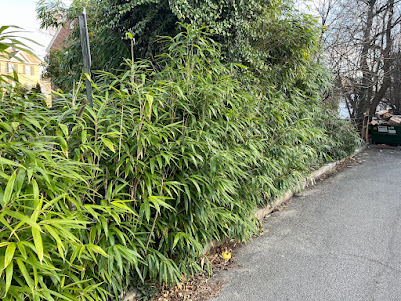A recurring observation, which this blog has long sought to make less common, is that many people go through life knowing little about the natural world all around them. Kids can navigate the school years without gaining acquaintance with more than a handful of native plants. Princeton University students can tend to remain cloistered on campus, studying distant continents while leaving the local unexplored.
A salve for this concern came this past fall when twenty Princeton University students gathered for a walk through Herrontown Woods. They had signed up for professor Andy Dobson's Ecology of Fields, Streams, and Rivers--a course that combined standard lecture with field trips to "local sites of ecological interest," including Herrontown Woods, Mountain Lakes, the Institute Woods, Terhune Orchards, and lands preserved more recently by the Ridgeview Conservancy.
What a delight to show them the all-too-rare forest opening in the Botanical Art Garden, where wildflowers team in the gaps between scattered trees. They witnessed the rebound of spicebush, as browsing pressure from deer has been brought more into balance, and the foundational, enduring open space legacy of the late great professor Oswald Veblen and his wife Elizabeth.
We learned a new word, "solastalgia." Coined less than 20 years ago, the word captures a kind of loss we are becoming more and more familiar with. If nostalgia is a longing for a place or time left behind, solastalgia is the distress felt when the world we thought we knew does the leaving. The word captures the present era, as climate change steals the seasons, rapid development transforms once familiar landscapes, and even foundational systems like democracy become threatened.
Another presentation told of the peach-clematis aphid, which lives two lives--one on peach-related trees, another on the non-native autumn clematis vine that blooms bright white in yards and in the wild. Andy pointed out that the resourceful aphid reproduces sexually on one, asexually on the other. This interaction between a nonnative insect and a nonnative plant is reminiscent of how the spotted lanternflies are drawn to the tree of heaven (Ailanthus)--the two having evolved together in Asia before being transported here.
It was satisfying to see, as well, that Andy's course led one student to discover the fascinating world of fire ecology, that is, how plants of many sorts have adapted to and even become dependent upon the periodic presence of fire in the landscape. Her presentation brought back memories of my first happening upon the concept in my second year in college, exactly 50 years ago. I was on Ossabaw Island off the coast of Savannah, wondering why the pines were burying themselves in pine needles so thick that no new pines could grow. The answer, discovered pre-internet in books and articles, was that the pines dropped persistent needles as an evolved strategy to promote periodic fire that would leave the pines intact while exposing the mineral soil for seed germination and killing the pine's less fire-resistant competitors.
By teaching a course on local ecology, Professor Dobson is in part building on the great tradition of one of his predecessors in the Department of Ecology and Evolutionary Biology, Henry Horn, who frequently reached beyond the university's borders to lead walks in local preserves. Some engaging videos of Henry's walks are online, and Henry's wife, Elizabeth Horn, continues to teach a wildflower course at the Princeton Adult School. I looked back and found another great example of university students learning from local habitats: when history professor Vera Candiani had architectural historian Clifford Zink and me introduce her students to Mountain Lakes' flora and history.
Courses past and gratefully present demonstrate the potential for synergy between town, gown, and outdoors, and somehow brought to mind the imperative found long ago in the Grateful Dead's song "Truckin'":
"Get out of the door and light out and look all around."
Most of what stuck with me from college happened outside the classroom. And though the distant world may beckon, there's a whole lot of truckin' and learnin' to be done just beyond one's doorstep.





















